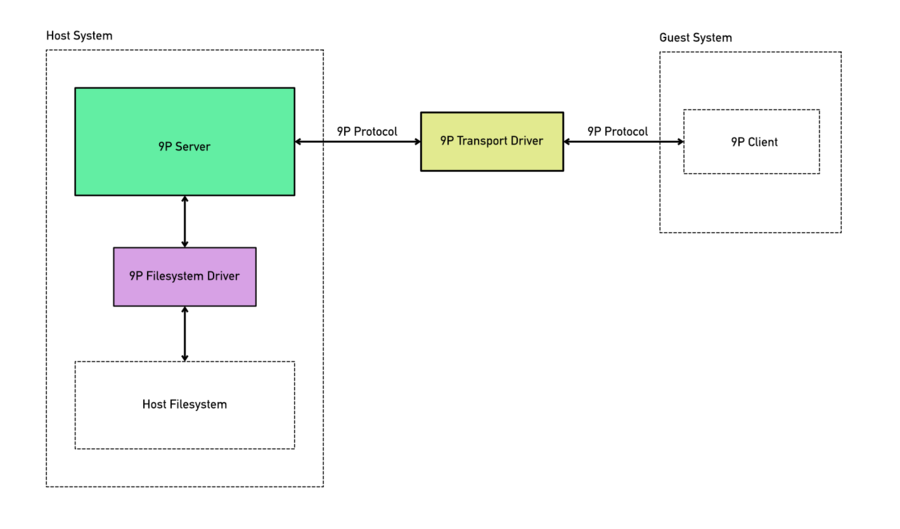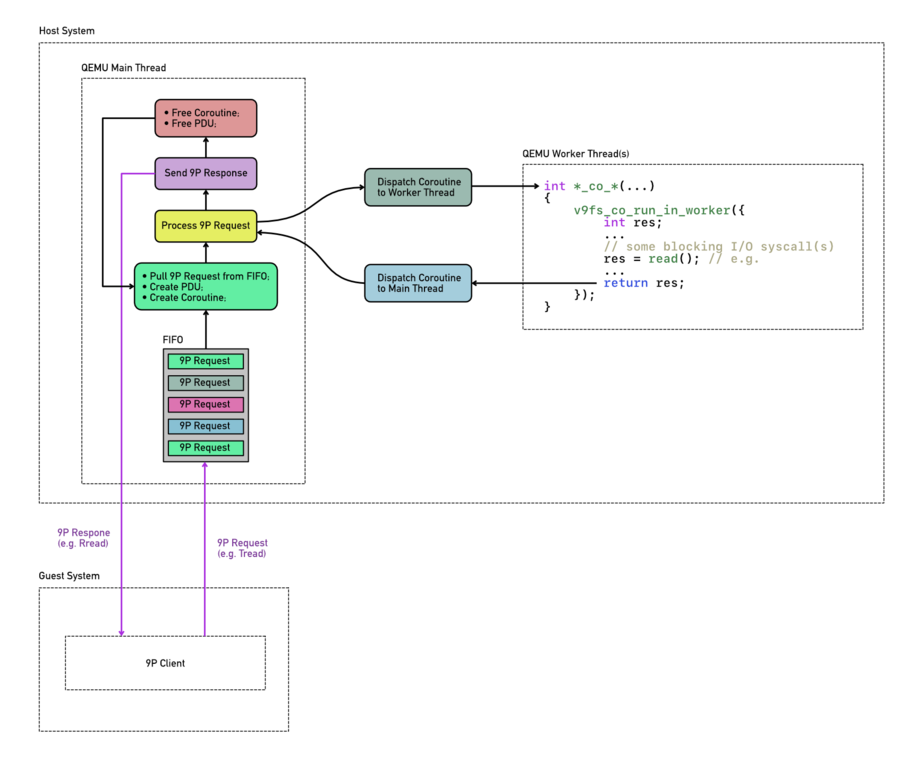Documentation/9p
9pfs Developers Documentation
This page is intended for developers who want to put their hands on the 9p passthrough filesystem implementation in QEMU. For regular user aspects you rather want to look at the separate page Documentation/9psetup instead.
9p Protocol
9pfs uses the Plan 9 Filesystem Protocol for communicating the file I/O operations between guest systems (clients) and the 9p server (see below). There are a bunch of separate documents specifying different variants of the protocol, which might be a bit confusing at first, so here is a summary of the individual protocol flavours.
Introduction
If this is your first time getting in touch with the 9p protocol then you might have a look at this introduction by Eric Van Hensbergen which is an easy understandable text explaining how the protocol works, including examples of individual requests and their response messages: Using 9P2000 Under Linux
There are currently 3 dialects of the 9p network protocol called "9p2000", "9p2000.u" and "9p2000.L". Note that QEMU's 9pfs implementation only supports either "9p2000.u" or "9p2000.L".
9p2000
This is the basis of the 9p protocol the other two dialects derive from. This is the specification of the protocol: 9p2000 Protocol
9p2000.u
The "9p2000.u" dialect adds extensions and minor adjustments to the protocol for Unix systems, especially for common data types available on a Unix system. For instance the basic "9p2000" protocol version only returns an error text if some error occurred on server side, whereas "9p2000.u" also returns an appropriate, common POSIX error code for the individual error. 9p2000.u Protocol
9p2000.L
Similar to the "9p2000.u" dialect, the "9p2000.L" dialect adds extensions and minor adjustments of the protocol specifically for Linux systems. Again this is mostly targeted at specializing for data types of system calls available on a Linux system. 9p2000.L Protocol
Topology
The following figure shows the basic structure of the 9pfs implementation in QEMU.
The implementation consists of 3 modular components: 9p server, 9p filesystem drivers and 9p transport drivers. The 9p client on guest OS side is not part of the QEMU code base. There are a bunch of 9p client implementations e.g. for individual OSes. The most commonly used one is the client that comes with the stock Linux kernel. Linux 9p Client
9p Server
This is the controller portion of the 9pfs code base which handles the raw 9p network protocol handling, and the general high-level control flow of 9p clients' (the guest systems) 9p requests. The 9p server is basically a full-fledged file server and accordingly it has the highest code complexity in the 9pfs code base, most of this is in hw/9pfs/9p.c source file.
9p Filesystem Drivers
The 9p server uses a VFS layer for the actual file operations, which makes it flexible from where the file storage data comes from and how exactly that data is actually accessed. There are currently 3 different 9p file system driver implementations available:
1. local fs driver
This is the most common fs driver which is used most often with 9p in practice. It basically just maps the individual VFS functions (more or less) directly to the host system's file system functions like open(), read(), write(), etc. You find this fs driver implementation in hw/9pfs/9p-local.c source file.
2. proxy fs driver
This fs driver was supposed to dispatch the VFS functions to be called from a separate process (by virtfs-proxy-helper) and increasing security by that separation, however the "proxy" driver is currently not considered to be production grade. 9p-proxy.c
3. synth fs driver
This fs driver is only used for development purposes. It just simulates individual filesystem operations with specific test scenarios in mind, and therefore is not useful for anything on a production system. The main purpose of the "synth" fs driver is to simulate certain fs behaviours that would be hard to trigger with a regular (production) fs driver like the "local" fs driver for instance. Right now the synth fs driver is used by the automated 9pfs test cases and by the automated 9pfs fuzzing code. The automated test cases use the "synth" fs driver for instance to check the 9p server's correct behaviour on 9p Tflush requests, which a client may send to abort a file I/O operation that might already be blocking for a long time. In general the "synth" driver is very useful for effectively simulating any multi-threaded use case scenarios. 9p-synth.c
9p Transport Drivers
The third component of the 9pfs implementation in QEMU is the "transport" driver, which is the communication channel between host system and guest system used by the 9p server. There are currently two 9p transport driver implementations available in QEMU:
1. virtio transport driver
The 9p "virtio" transport driver uses e.g. a virtual PCI device and ontop the virtio protocol to transfer the 9p messages between clients (guest systems) and 9p server (host system). virtio-9p-device.c
2. Xen transport driver
TODO xen-9p-backend.c
Threads and Coroutines
The following figure shows the control flow and relationship of threads and coroutines of the 9pfs implementation.
Test Cases
Whatever you are doing there on the 9pfs code base, please run the automated test cases after you modified the source code to ensure that your changes did not break the expected behaviour of 9pfs. Running the tests is very simple and does not require any guest OS installation, nor is any guest OS booted, and for that reason you can run them in few seconds. The test cases are also a very efficient way to check whether your 9pfs changes are actually doing what you want them to while still coding.
To run the 9pfs tests e.g. on a x86 system, all you need to do is executing the following two commands:
export QTEST_QEMU_BINARY=x86_64-softmmu/qemu-system-x86_64
tests/qtest/qos-test -m slow
All 9pfs test cases are in tests/qtest/virtio-9p-test.c source file.
As you can see at the end of the virtio-9p-test.c file, the 9pfs test cases are split into two groups of tests. The first group of tests use the "synth" fs driver, so all file I/O operations are simulated and basically you can add all kinds of hacks into the synth driver to simulate whatever you need to test certain fs behaviours, no matter how exotic that behaviour might be.
The second group of tests use the "local" fs driver, so they are actually operating on real dirs and files in a test directory on the host filesystem. Some issues that happened in the past were caused by a combination of the 9p server and the actual "local" fs driver that's usually used on production machines. For that reason this group of tests are covering issues thay may happen across these two components of 9pfs. Again, this works without any guest OS, which has the advantage that you can test the behaviour independent of third-party 9p client implementations.
Contribute
Please refer to Contribute/SubmitAPatch for instructions about how to send your patches.


